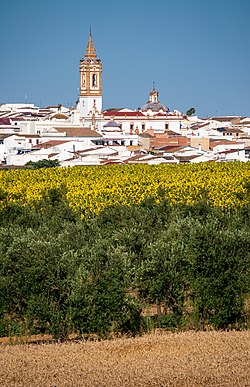
Huelva is a municipality of Spain and the capital of the province of Huelva, in the autonomous community of Andalusia. Located in the southwest of the Iberian Peninsula, it sits between the estuaries of the Odiel and Tinto rivers on the Atlantic coast of the Gulf of Cádiz. According to the 2010 census, the city had a population of 149,410.

Palos de la Frontera is a town and municipality located in the southwestern Spanish province of Huelva, in the autonomous community of Andalusia. It is situated some 13 km (8 mi) from the provincial capital, Huelva. According to the 2015 census, the city had a population of 10,365. It is most famous for being the place from which Columbus set sail in 1492, eventually reaching the Americas.

The Kingdom of Castile was a polity in the Iberian Peninsula during the Middle Ages. It traces its origins to the 9th-century County of Castile, as an eastern frontier lordship of the Kingdom of León. During the 10th century, the Castilian counts increased their autonomy, but it was not until 1065 that it was separated from the Kingdom of León and became a kingdom in its own right. Between 1072 and 1157, it was again united with León, and after 1230, the union became permanent.
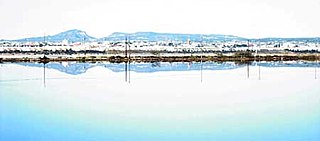
San Pedro del Pinatar is a small town and municipality in the Region of Murcia, southeastern Spain. The municipality is situated at the northern end of Murcia's Mediterranean coastline, the Costa Cálida, and borders the province of Alicante. It has an area of almost 22 km2, and a population of 25,167 as of 2018.

Jumilla is a town and a municipality in southeastern Spain. It is located in the north east of the Region of Murcia, close to the towns of Cieza and Yecla. According to the 2018 census, the town population was 25,547.
This is a timeline of notable events during the period of Muslim presence in Iberia, starting with the Umayyad conquest in the 8th century.

The House of Medina Sidonia is a Spanish noble house originating from the crown of Castile, whose name comes from the Duke of Medina Sidonia, a hereditary noble title that John II of Castile granted to Juan Alonso Perez de Guzman, 3rd Count of Niebla, on February 17, 1445, as a reward for his services to the crown. The Dukedom of Medina Sidonia is the oldest hereditary dukedom in the kingdom of Spain.

Marvão is a municipality in Portalegre District in Portugal. The population in 2020 was 2,972, in an area of 154.90 km2. The present Mayor is Luís Vitorino, elected by the Social Democratic Party. The municipal holiday is September 8.
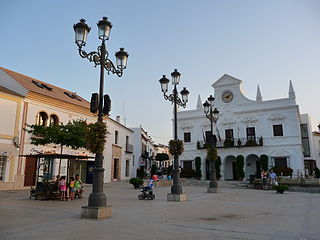
Cartaya is a Spanish locality and municipality in the Province of Huelva,. In 2010 it had 18,415 inhabitants. Its surface area is 226.4 km2 and has a density of 81.34 people per km2.

Niebla is a town and municipality located in the province of Huelva, in Andalusia, southern Spain. It lies on the banks of the Rio Tinto, 30 km from Huelva and 60 km from Seville.

Cabra is a municipality in Córdoba province, Andalusia, Spain and the site of former bishopric Egabro. It lies along the route between Córdoba and Málaga in the south of Spain. It is an entrance point to the Parque Natural de las Sierras Subbéticas.
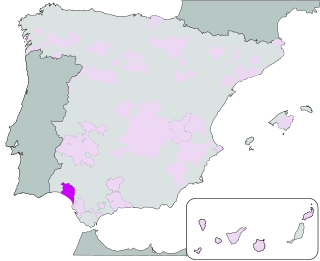
Condado de Huelva is a Spanish Denominación de Origen Protegida (DOP) for wines located in the south-east of the province of Huelva. The wines, known as the Wines of the Discovery of America, are produced there.

Navas de San Juan is a Spanish village of the province of province of Jaén, Spain. According to the 2005 census (INE), the city has a population of 5,030 inhabitants. It is the biggest village in the region of El Condado. The river called Guadalimar runs for its municipal area.
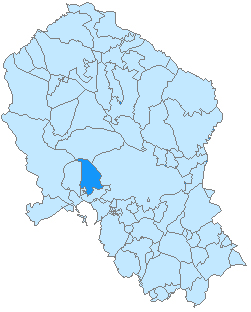
Almodóvar del Río is a small historic city located in the province of Córdoba, Spain, located in the Valle Medio del Guadalquivir Comarca. In 2022, there were 8093 inhibitants. It belongs to the judicial district of Posadas.

The Taifa of Seville was an Arab kingdom which was ruled by the Abbadid dynasty. It was established in 1023 and lasted until 1091, in what is today southern Spain and Portugal. It gained independence from the Caliphate of Cordoba and it expanded the territory it ruled in the mid-11th century. The emerging power of Castile led Seville to ask military assistance from the Almoravids, who then occupied Seville.

The Romería de El Rocío is a procession/pilgrimage on the second day of Pentecost to the Hermitage of El Rocío in the countryside of Almonte (Huelva), Andalucia, Spain, in honor of the Virgin of El Rocío. In recent years the Romería has brought together roughly a million pilgrims each year.

Saltes Island is a fluvial islet in the Huelva River estuary, in the province of Huelva, Andalusia, Spain. It is part of the Odiel Marshes biosphere reserve.
The siege of Jerez by King Alfonso X of Castile took place in 1261, presumably in the late spring or early summer. It resulted in the incorporation of Jerez de la Frontera into the Crown of Castile.

The Mudéjar revolt of 1264–1266 was a rebellion by the Muslim populations (Mudéjares) in the Lower Andalusia and Murcia regions of the Crown of Castile. The rebellion was in response to Castile's policy of relocating Muslim populations from these regions and was partially instigated by Muhammad I of Granada. The rebels were aided by the independent Emirate of Granada, while the Castilians were allied with Aragon. Early in the uprising, the rebels managed to capture Murcia and Jerez, as well as several smaller towns, but were eventually defeated by the royal forces. Subsequently, Castile expelled the Muslim populations of the reconquered territories and encouraged Christians from elsewhere to settle their lands. Granada became a vassal of Castile and paid an annual tribute.
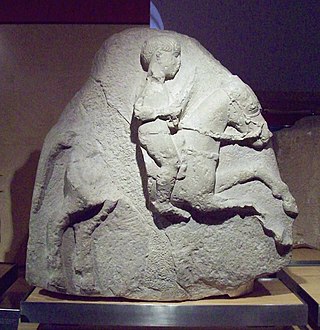
The geostrategic position of Andalusia, at the southernmost tip of Europe, between Europe and Africa and between the Atlantic Ocean and the Mediterranean Sea, has made it a hub for various civilizations since the Metal Ages. Its wealth of minerals and fertile land, combined with its large surface area, attracted settlers from the Phoenicians to the Greeks, who influenced the development of early cultures like Los Millares, El Argar, and Tartessos. These early Andalusian societies played a vital role in the region’s transition from prehistory to protohistory.
